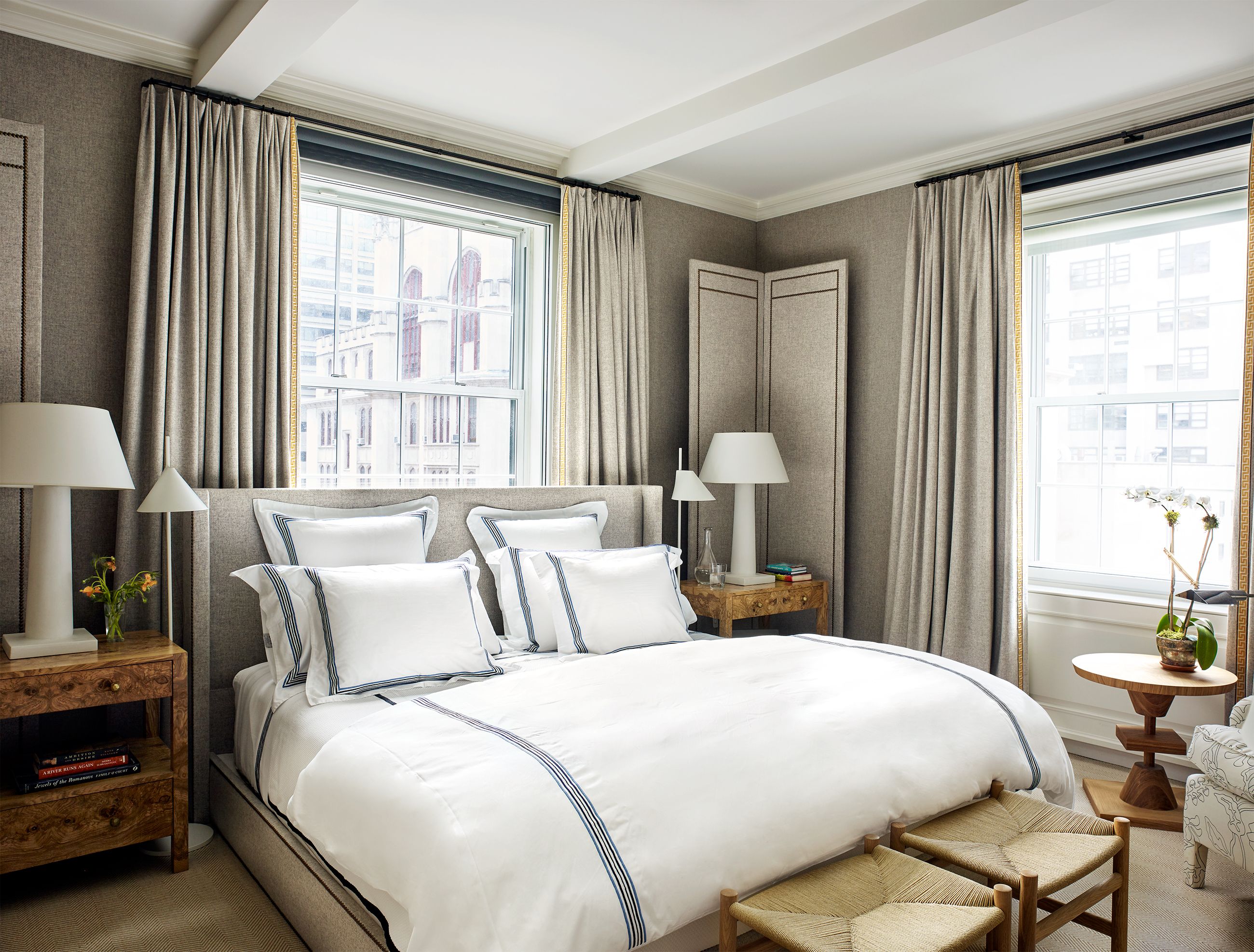Types of Curtains for Bedroom: What Type Of Curtains For Bedroom

Choosing the right curtains for your bedroom is a crucial step in creating a comfortable and aesthetically pleasing space. Curtains not only enhance the visual appeal of your room but also play a significant role in controlling light, privacy, and temperature. From the sheer elegance of voile curtains to the light-blocking power of blackout curtains, a wide range of curtain types are available to cater to diverse preferences and needs.
Types of Curtains
Curtains are a versatile and essential element of interior design, offering a multitude of options to suit various styles and functionalities. Here’s a comprehensive overview of popular curtain types commonly used in bedrooms, along with their pros and cons:
- Blackout Curtains: These curtains are designed to block out almost all light, making them ideal for bedrooms where darkness is crucial for sleep. They are typically made from thick, tightly woven fabrics like polyester or microfiber, often with an additional lining.
- Pros: Excellent light blocking, enhanced privacy, improved insulation, suitable for shift workers or light sleepers.
- Cons: Can make the room feel darker during the day, may be less aesthetically pleasing compared to other types, can be heavier and more expensive.
- Sheer Curtains: Known for their delicate and airy appearance, sheer curtains are made from lightweight, translucent fabrics like voile or organza. They allow natural light to filter through, creating a soft and diffused glow.
- Pros: Elegant and airy aesthetic, provide privacy without completely blocking light, can be used as a standalone curtain or layered with heavier curtains.
- Cons: Offer minimal light blocking, may not provide sufficient privacy in some situations, susceptible to fading from prolonged sun exposure.
- Thermal Curtains: These curtains are designed to insulate your room, reducing heat loss in winter and heat gain in summer. They are typically made from thick, woven fabrics with a layer of insulation, such as foam or fleece.
- Pros: Improved energy efficiency, reduced noise levels, can contribute to a more comfortable sleep environment.
- Cons: Can be heavier and more expensive than other types, may not offer sufficient light blocking for some individuals.
- Patterned Curtains: These curtains come in a wide variety of patterns, colors, and designs, adding a decorative touch to your bedroom. From floral prints to geometric patterns, they can complement your existing décor or create a focal point in the room.
- Pros: Add visual interest and personality to the room, can create a sense of depth and dimension, offer a wide range of design options to suit different styles.
- Cons: May be overwhelming in small rooms, can clash with other patterns in the room if not carefully chosen, may require more frequent cleaning to maintain their appearance.
Curtain Types and Bedroom Styles
The choice of curtain type can significantly influence the overall aesthetic of your bedroom. Here’s a table showcasing how different curtain types can complement various bedroom styles:
| Curtain Type | Characteristics | Suitable for Bedroom Styles |
|---|---|---|
| Blackout Curtains | Thick, light-blocking fabric, often with lining | Modern, Minimalist, Contemporary |
| Sheer Curtains | Lightweight, translucent fabric, allows light to filter through | Bohemian, Romantic, Traditional |
| Thermal Curtains | Thick, insulated fabric, reduces heat loss and noise | Modern, Minimalist, Contemporary, Traditional |
| Patterned Curtains | Variety of patterns, colors, and designs | Bohemian, Eclectic, Traditional |
Factors to Consider When Choosing Curtains

The selection of curtains for your bedroom is not merely an aesthetic decision; it significantly impacts the functionality and overall ambiance of the space. This critical choice requires careful consideration of several key factors to ensure the perfect blend of style, practicality, and personal preferences.
Window Size and Room Size
The dimensions of your windows and the overall size of the bedroom play a crucial role in determining the appropriate curtain style and size. Larger windows in expansive bedrooms can accommodate grander curtains, while smaller windows in compact rooms require a more subtle approach.
- For larger windows: Consider floor-length curtains that extend beyond the window frame, creating a sense of grandeur and adding visual height to the room. Opt for heavier fabrics like velvet or brocade to make a bold statement.
- For smaller windows: Choose shorter curtains that end above the windowsill or opt for sheer fabrics that allow maximum light penetration and create an airy feel. Avoid overly bulky curtains that can overwhelm the space.
Desired Light Level
The amount of natural light you desire in your bedroom is a key factor in choosing the right curtain material.
- For complete darkness: Blackout curtains are the ideal solution, blocking out all light and creating a perfect environment for sleep.
- For filtered light: Sheer curtains provide a soft, diffused light, allowing for a tranquil and airy atmosphere.
- For privacy: Lined curtains offer privacy without completely blocking out light.
Personal Style, What type of curtains for bedroom
Ultimately, the curtains you choose should reflect your personal taste and complement the existing décor of your bedroom.
- Minimalist: Simple, solid-colored curtains in neutral tones like white, gray, or beige create a clean and uncluttered look.
- Bohemian: Embroidered, patterned, or textured curtains in vibrant colors and natural fabrics like cotton or linen add a touch of whimsy and personality.
- Traditional: Classic designs with intricate details, such as damask or floral patterns, in rich colors like burgundy or emerald green create a sophisticated and timeless atmosphere.
Flowchart for Choosing the Right Curtains
The following flowchart provides a visual representation of the decision-making process for choosing curtains:
[Flowchart illustration describing the decision-making process, starting with “Window Size and Room Size,” then branching out to “Desired Light Level,” and finally converging to “Personal Style.” Each branch should have options like “Large,” “Small,” “Complete Darkness,” “Filtered Light,” “Minimalist,” “Bohemian,” “Traditional,” etc., leading to the final decision of “Curtain Style.”]
Curtain Styling and Design Tips

Curtains can transform a bedroom from ordinary to extraordinary, enhancing its visual appeal and creating a personalized atmosphere. To achieve this, understanding the nuances of curtain styling and design is crucial.
Curtain Length
The length of your curtains plays a significant role in the overall look and feel of your bedroom. Curtains that reach the floor create a sense of grandeur and elegance, while shorter curtains can add a touch of casualness.
- Floor-length curtains: These curtains extend to the floor, creating a dramatic and sophisticated look. They are best suited for formal bedrooms and those with high ceilings.
- Curtains that hit the window sill: This length is practical and provides privacy without obstructing the view. It is a good choice for bedrooms with limited space.
- Curtains that graze the floor: These curtains are a happy medium between floor-length and sill-length curtains. They offer a touch of elegance without being too overwhelming.
Fabric Selection
The fabric of your curtains will affect their drape, texture, and light-filtering properties. Consider the following factors when choosing fabric:
- Light filtering: Choose blackout curtains for bedrooms that need complete darkness, or sheer curtains for bedrooms that need a light and airy feel.
- Drape: Heavier fabrics like velvet and linen create a luxurious and formal look, while lighter fabrics like cotton and silk create a more relaxed and casual feel.
- Texture: Consider the overall style of your bedroom and choose a fabric that complements the existing textures. For example, a bedroom with a modern aesthetic might benefit from a smooth and sleek fabric, while a bedroom with a traditional style might benefit from a more textured fabric.
Color Coordination
Curtain color can significantly impact the overall mood of your bedroom. Consider the following:
- Neutral colors: These colors create a calming and relaxing atmosphere. They are a versatile choice that can be easily paired with other colors and patterns.
- Bold colors: These colors can add a touch of personality and vibrancy to your bedroom. They are best used in small doses, such as with accent curtains or patterned curtains.
- Complementary colors: These colors are opposite each other on the color wheel and create a harmonious and visually appealing combination.
- Analogous colors: These colors are next to each other on the color wheel and create a cohesive and calming effect.
Curtain Hanging
The way you hang your curtains can also impact the overall look of your bedroom.
- Curtain rods: Curtain rods are a classic and versatile option. They come in a variety of styles and materials, allowing you to create a custom look.
- Curtain tracks: Curtain tracks are a more modern and practical option. They are ideal for large windows or sliding doors, and they allow you to easily open and close your curtains.
- Valances: Valances are decorative pieces that are often used to cover the top of curtain rods or tracks. They can add a touch of elegance and sophistication to your bedroom.
